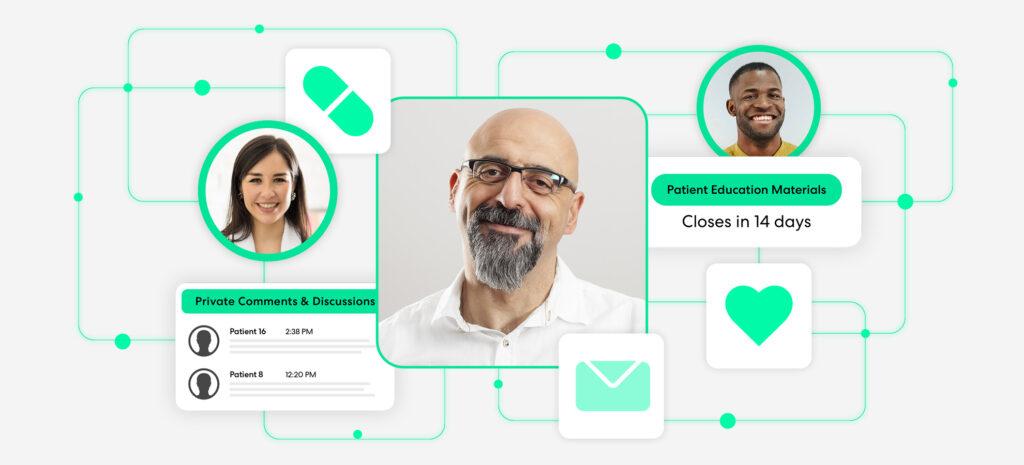Healthcare and life science organizations are increasingly changing their operational models to a patient-centric rather than a disease-focused approach. What does this mean for pharmaceutical and medical device companies conducting clinical research, developing treatments, and going to market? In many cases, rethinking how patient care is delivered or how drugs and devices are developed will require major organizational change. Let’s discuss the basics of patient-centric culture, the benefits of such a culture, and how to start adopting it within your team or broader organization.
The expectation that patients will be involved in the design, running, and evaluation of the research process has shifted from a lofty ambition to a grounded expectation. – PharmExec.com
What is a patient-centric culture?
In medical and life science settings, a patient-centric culture leaves behind traditional notions of a healthcare provider-driven, disease-focused approach in favor of a system that ensures individual patient preferences, needs, desires, and experiences are integrated into every aspect of healthcare. Before the pandemic, just 47% of patients said they felt pharmaceutical companies understood their emotional, financial, and other needs related to their condition, and only a third reported interacting with a pharmaceutical company on a regular basis. There is an opportunity for life science companies to build stronger relationships with the people they serve.
In a patient-centric model, patients are empowered to meet their health goals by partnering with physicians or drug manufacturers. In the latter case, patients are involved from the early stages of drug development through post-market monitoring. Patients can have input at every stage and know their experiences are represented.
For years, pharma’s business model was primarily based on the profits from the discovery and commercialization of the drug development process. Drug development that was unlikely to be profitable wasn’t well-funded, leaving some rare diseases unaddressed. Now, pharma companies are more willing to take a patient-centric approach but are often confused about patient-centered research.
A patient-centric culture is based on the notion that patients “know best about the physical practicalities of their treatment,” and that looking to patients to provide this knowledge has the following benefits:
- Patient virtual advisory boards help avoid potential oversights, such as people with chronic fatigue illnesses being asked to travel to a remote site repeatedly
- Full patient consultation around trial design helps boost engagement, retention, and recruitment rates, resulting in a higher-quality patient data set
- Co-design of the trial process, including patient selection and consultation with advocacy groups, leads to increased diversity in previously under-represented groups
What are the benefits of a patient-centric culture?
For hospitals and any healthcare system, switching to a patient-centric culture can result in improved public perception, increased profits, higher patient satisfaction, and other critical business metrics. For pharmaceutical and medical device companies, operationalizing patient-centricity can result in:
- Higher volume of actionable patient insight at every stage of product development
- Designing more successful clinical trials
- Lower discontinuation rate in clinical trials
- Higher degree of consumer trust over the long term
- Improved patient outcomes
An old-school view of patient centricity in pharma dictates that an increased patient focus equates to lagging sales. But research shows that most people in pharma roles around the world believe that a patient-focused strategy improves overall business outcomes by increasing HCP trust, employee and stakeholder engagement, patient trust, and payer and government trust.
How can I adopt a patient-centric culture?
According to research conducted by Deloitte, there are four critical strategies that life sciences companies should consider as they evolve their patient-centricity focus:
- Identify concrete objectives around incorporating the patient perspective into different processes throughout the life cycle and operationalize them
- Track progress toward delivering (sometimes nontraditional) key performance indicators and return on investment
- Harness digital and data analytics opportunities to engage the patient and collect data on patient outcomes as well as their unmet needs
- Form deeper collaborations within the healthcare industry, with advocacy groups, clinicians, and health plans, and leverage lessons learned from other industries that excel at customer-centricity such as retail and consumer technology
As life science companies increasingly embrace digital transformation across their operations, patient engagement should not be left behind. A hybrid virtual patient engagement strategy enables a true patient focus: clinical teams can design patient-centric trials with the right virtual engagement tactics and tools, and the patient story can enable medical affairs teams to help healthcare professionals understand more about the patient experience. Commercial teams can solicit candid patient input to craft messages with a better understanding of the medical and emotional implications of a particular diagnosis.
Collecting insights within a virtual engagement platform supports both a patient-centric operational model as well as patients themselves by providing accessible, secure access to a forum where their experiences are valued.
As the patient engagement landscape shifted throughout 2020, so did the sophistication of the measures used to facilitate it. Patients were unable to travel to in-person sites which hindered monitoring, and trials, in general, experienced severe disruption. Fortunately, virtual engagement technology can ease this process. – PharmExec.com
Building a patient-centric culture reinforces a life science company’s commitment to working toward better health outcomes for consumers. By eliminating barriers to communications and including patients as experts in their own right, pharma and medical device teams can add a new dimension and more value to the product development process.
Want to learn more about how technology is changing patient expectations? Read our blog post.






